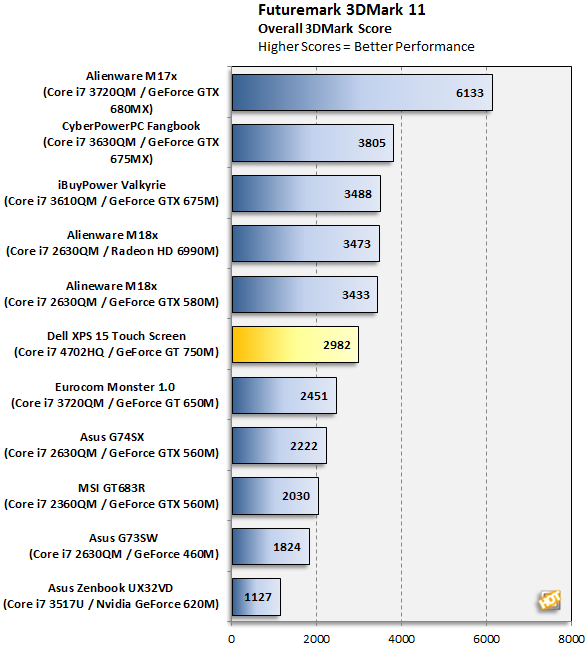Dell XPS 15 Touch Screen Laptop Review
|
As a synthetic gaming benchmark, 3DMark 11 puts extra emphasis on your system’s handling of DirectX 11. However, 3DMark 11 measures more than just the graphics card’s performance; the processor has a definite influence on the score. As a result, this benchmark is a good way to get a feel for how well the system can handle gaming and general computing tasks.

With that in mind, the XPS 15 Touch impressively carves out a space in the middle ground, standing on the shoulders of previous generation laptops built specifically for gaming and resting within arm's reach of systems with strong GPUs. The lone exception is Dell's Alienware M17x, a powerfully equipped single-GPU gaming system that's in a class of its own.
|
3DMark is the flagship benchmark in Futuremark’s catalog. As a result, it is a popular choice for testing all types of computers. Recognizing the technology differences between different types of PCs are significant, 3DMark has a separate test suite for each device category. The Cloud Gate test is aimed at entry-level PCs and laptops. It has two subtests: a processor-intensive physics test and two graphics tests. Cloud Gate uses a DirectX 11 engine but the graphics are designed to be compatible with DirectX 10 systems. We ran the test suite at its default 1280 x 720 resolution and at default rendering quality settings. It’s important to remember that 3DMark Cloud Gate scores aren’t comparable to scores from other categories such as 3DMark Fire Strike (gaming PCs) or Ice Storm (smartphones and tablets).

|
Far Cry 2 uses high-quality texture, complex shaders, and dynamic lighting to create a realistic environment. Using the game’s built-in benchmark, we can get a better look at a system’s performance with DirectX 10 level gaming graphics.

As dated as Far Cry 2 is at this point, we still use it to measure system performance both because we have a large database of configurations to compare scores with and also because systems with integrated graphics still struggle with it. That obviously isn't an issue for the XPS 15 Touch with its discrete GeForce GT 750M GPU, which pulled way out ahead.

Of course, it would be a shame to run anything on this laptop at 1280x720, and when we cranked the resolution up to 1920x1080 and turned on 4xAA, framerates dipped in half to 54.03fps. Compared to dedicated gaming laptops with single GPU configurations, the XPS 15 Touch falls in about the middle, right behind a pair of Alienware systems. That's a good showing for a system that offers gaming performance as an afterthought.






